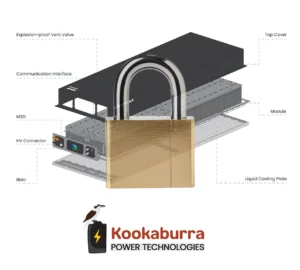 You need to wonder, is cybersecurity in BESS really just another IT checklist, or should it sit squarely at the executive table?
You need to wonder, is cybersecurity in BESS really just another IT checklist, or should it sit squarely at the executive table?
Today’s batteries aren’t just hardware bolted into containers. They are software-driven assets, and that changes the game completely.
This battery module is where it starts, but resilience has to extend from the cell right through to the grid. At the system level, EMS, PPC, SCADA, and cloud platforms create a digital ecosystem that most operators now depend on. Add Wi-Fi, Bluetooth, and cloud data management, and you’ve opened doors that traditional energy infrastructure never had to worry about.
That complexity creates opportunity, but also real risk: firmware manipulation, cloud outages, or intrusions that ripple into grid stability events, the kind Denmark’s energy sector has already had to face.
Which is why cybersecurity for BESS isn’t a technical footnote. It’s a board-level risk. It goes to the heart of stability, performance and trust.
At Kookaburra Power Technologies, we’re building that into our DNA:
1. Aligning with ISO 27001 and IEC 62443
2. Setting IT/software terms into contracts
3. Running cyber playbooks alongside fire and safety protocols
4. Strengthening real-time monitoring and anomaly detection
As batteries shift from ‘optional’ to critical infrastructure, keeping renewables firm and mitigating demand peaks, executive teams should be certain that digital resilience is as strong as physical performance.
Why battery packs need to be considered in your cybersecurity risks and planning
Why battery packs need to be considered in your cybersecurity risks and planning
- Digital control at the cell level: Battery management systems (BMS) monitor temperature, voltage, current and state of charge in real-time. They’re networked, programmable and, if improperly secured, vulnerable to intrusion.
- Connected systems mean connected risks: BESS units communicate with grid control systems, inverters and energy management platforms. A compromised battery pack could be forced to overcharge, discharge erratically or shut down entirely, triggering grid instability or cascading failures.
- The firmware gap: While operators focus on network perimeters and SCADA systems, embedded firmware inside battery packs often goes unexamined. These are potential entry points for malware or remote manipulation.
- Physical consequences are real: A targeted cyberattack on battery packs could trigger thermal runaway, resulting in fires or explosions. This isn’t just a digital risk, it’s a safety-critical one.
At Brunstock, they design BESS with cybersecurity built in from the CELL up. If you’re deploying energy storage, let’s discuss how we can mitigate these threats.
Talk to Kookaburra Power Technologies today about how Brunstock BESS mitigates the above threats and risks.
#KTECK #CyberSecurity #BESS #Renewables #RenewableEnergy #EnergyStorage #Australia
